In India, bananas account for 37% of total fruit production. As a percentage of India’s total cropland, bananas occupy 20%. The state of Maharashtra ranks second in terms of area and first in terms of productivity in India. Maharashtra’s Jalgaon district is a major banana-growing area. However, most bananas are grown from suckers.
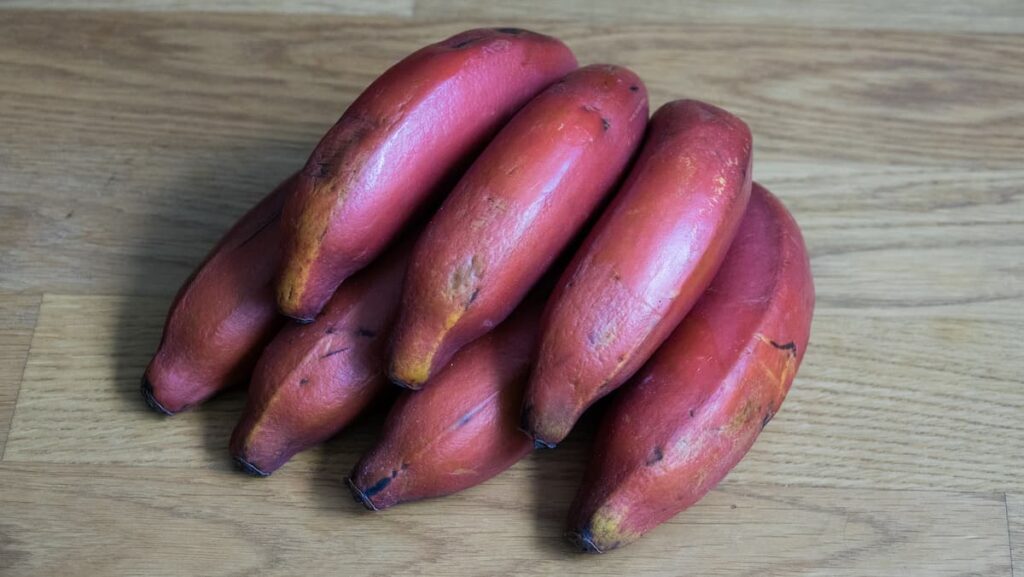
As a result of rapid technological development in agriculture, the Tissue Culture Technique has been developed. Around the world, there are more than 1,000 varieties of bananas. A red banana is a banana from Southeast Asia with red skin. Musa acuminata is a Musaceae (banana tree) member and goes by the common name “red banana tree.”
Red banana farming in India
Characteristics of Red Banana
- Plants like this are evergreen perennials, not trees. From a rhizome, this fast-growing giant herb develops a false trunk 10 to 12 feet tall made of leaf sheaths emerging from partially or completely buried corms.
- A green pseudostem is adorned with black or brown spots. Ten to twelve leaves in a rosette are at the top of the false trunk.
- The leaves measure 10 to 11.5 feet long and 26 inches wide from elliptic to oblong.
- They are soft and have a sweet flavor when ripe. Some say they taste like a regular banana but with a hint of raspberry sweetness.
- Unlike most bananas harvested green, as their name suggests, the Red Banana variety is harvested in a reddish-green hue and ripens during and after shipping. Therefore, red Bananas, when ripe, should have a purplish hue.
- Compared to yellow cavendish bananas, red bananas tend to be smaller, curved to a square shape, and have a few angular ridges.
- The peel of the Banana is thick, tough, and smooth. It ripens from green to red-orange, bright red, dark red, yellow, to maroon. The colors of the peel will vary depending on the fruit’s antioxidant content, and matte peels may show some blemishes due to harvesting and shipping.
- Several brown spots will appear on the peel as the fruit ripens. A fruity and sweet aroma is released after removing the peel, revealing yellow-orange, ivory, or light pink flesh.
- Banana flesh is dry, chalky, and unpalatable when raw but becomes creamy, soft, dense, and tender as it ripens.
- A lesser-grown variety grows to an elevation of 1300 meters above mean sea level and is the most prized.
- Plants are tall, robust, pseudostem petiole, deep red color, and free suckering.
- Bunch 20-25 kg, over 100 fruits under good management practices.
- Crop duration 18 months. The average yield of red Bananas is 18 tones per acre.
Flowering and Fragrance
- There are male and female buds on the red banana tree’s spike, producing a mix of white and yellow flowers.
- Toward the top of the inflorescence, the male flowers develop between leathery purple-red bracts. In the meantime, the female flowers remain near the base of the plant.
- Fertilized flowers mature in approximately four months, starting at the base of the inflorescence and working their way up.
- A 50 to 150-finger-shaped berry grows to a length reflecting the number of seeds it contains (generally between 15 and 62).
- Like other banana trees, the fruits are grouped into hands of 10 to 20 fruits each.
Red Banana cultivating states in India
The red banana fruit is highly prized and relished, mainly grown in Kerala and Tamil Nadu. It is widely cultivated in the Kanyakumari and Tirunelveli districts of Tamil Nadu. Additionally, it is popular in western and central India, Karnataka, Andhra Pradesh, Maharashtra, and Andhra Pradesh. It is known as Lal Velchi in Bihar and other parts of the country, while Chandra Bale is in Karnataka.
In case you missed it: Agricultural Biotechnology in India: Role, Examples, Jobs, Salary, Courses, and Colleges
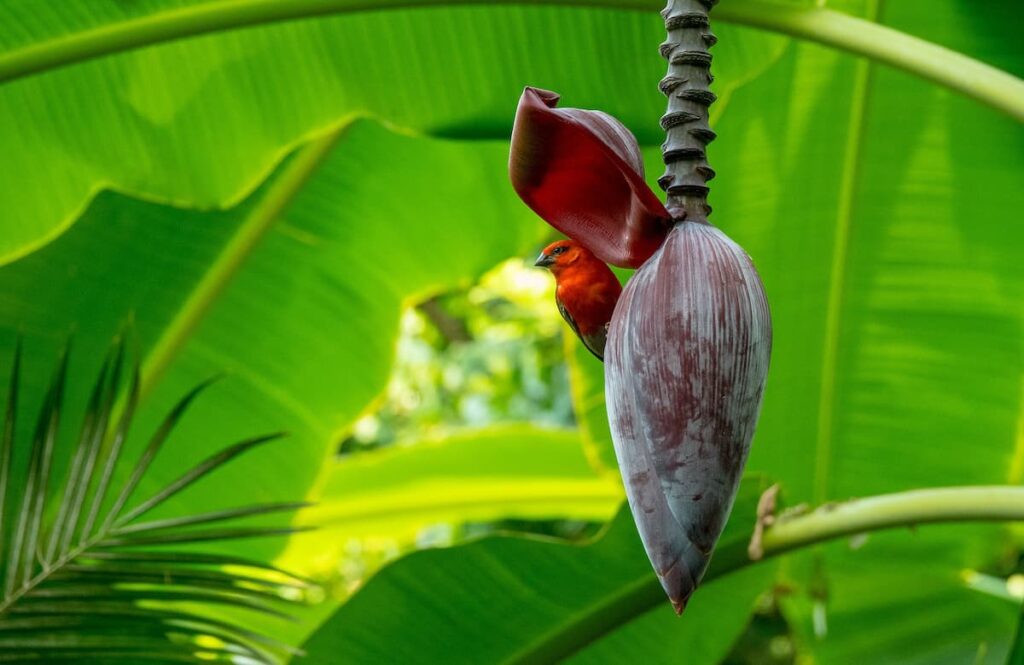
Soil Type for Red banana cultivation
Land with good drainage facilities can be chosen to cultivate Red banana saplings. Red soil and other moderate soil with less sand proportion will be suitable for Red banana plants. The pH of the soil should be neutral or between 5.5 -7.5. Thus, the soil should be subjected to the soil test in a suitable laboratory or government-based horticulture labs to confirm the pH of the soil. If the soil is more acidic, it is to be neutralized using gypsum and if the soil is more basic, neutralize it with Dolomite.
This neutralization is very important to make the soil suitable for cultivation. For bananas, the soil should be well-drained, fertile, and moist. It is not possible to cultivate bananas in soils that are saline, solid, and calcareous. It is best for bananas to grow in soil that is neither too acidic nor too alkaline, rich in organic material, with high nitrogen content and adequate phosphorus and potash levels.
Land Preparation and planting bananas in the field
Before planting a Banana, grow the green manuring crop like daincha, cowpea, etc., and bury them in the soil. The land can be plowed 2 to 4 times and leveled. Then, use a plow to break the clod, bringing the soil to a fine tilt. During soil preparation, a basal dose of FYM is added and thoroughly mixed into the soil. The holes should be 60 cm wide by 60 cm deep for planting.
Refilling the pits will involve mixing topsoil with 10 kg of FYM (well-decomposed), 250 grams of Neem cake, and 20 grams of carbofuran. Pits are left to solar radiation, which kills insects and helps prevent soil-borne diseases and aerating them. Organic matter must be incorporated into the Pit mixture in saline-alkali soils where PH is above 8. In addition to reducing salinity, organic matter and perlite improve porosity and aeration.
It is also possible to plant in furrows instead of pits. Soil strata and the appropriate method should determine plant spacing and depth. A good mix of manure and topsoil is essential. It would be best to plant the banana tree in the surface manure mixture around the roots; the subsoil, which is not as nutritious, should be spread as the top layer.
Agro-climatic requirements for Red banana cultivation
Optimal growing conditions for red bananas are 15°C – 35°C and 75-85% relative humidity. Growing from sea level to an elevation of 2000 m above mean sea level, it prefers humid tropical lowlands. Through a selection of varieties, this crop is cultivated in climates ranging from humid tropical to dry mild subtropical.
When the temperature falls below 12°C, chilling injury occurs. A high wind velocity exceeding 80 km/hr will also damage the crop. Average rainfall of 650 to 750 mm. during the four months of monsoon (June to September) is crucial to the vigorous vegetative growth of banana plants.
Treatment of suckers
- It is recommended that selected suckers be ‘pared’ by removing any rotten portions of the roots and surface layers.
- Put the pared suckers in 0.2% carbendazim solution (2g/liter of water) for about 15 – 20 minutes as a prophylactic measure against Fusarium wilt.
- After treating the suckers, keep them in the shade overnight before planting. Then, the suckers should be planted in the center of the pit and firmly pressed into the soil around them.
- Carbofuran granules of 40 g per pit should be applied to protect plants against nematode attacks. Irrigate the field thoroughly after applying the granules.
- One week before planting tissue culture plants, put 10 grams of Carbofuron and 1 percent bleaching powder or 0.2 percent Emissan in 100 ml water in the polythene bags as a drench to prevent nematode infestation and bacterial rot (Erwinia Rot).
Red banana planting
Banana plants should be planted at the beginning or during long rains. In the prepared hole, dig a central hole about 20 cm deep. Close the soil around the plant by pressing with your feet. Young plants should be watered regularly because banana trees need a lot of water for good growth. Farmers are advised to use tissue culture bananas from established nurseries, but suckers from existing plantations that are disease-free can still be used.
Suckers should be 1 to 1.5 meters high. Leaves and roots should be cut, especially in dry weather. The bulb (lower stem) can be peeled to eliminate pests or nematodes. At 1 ½ months, apply vermicompost at 1 ½ kg per tree, and on the 75th day, apply one basket of farmyard manure with 100 grams urea,120 grams potash, and 200 grams super phosphate for each tree. Within the 95-100th day, Azospirillum, vermicompost, and Phospho bacteria were at 200g per tree.
In case you missed it: Plant Nursery Business Plan in India: Startup Costs, Profit, License, and Taxes
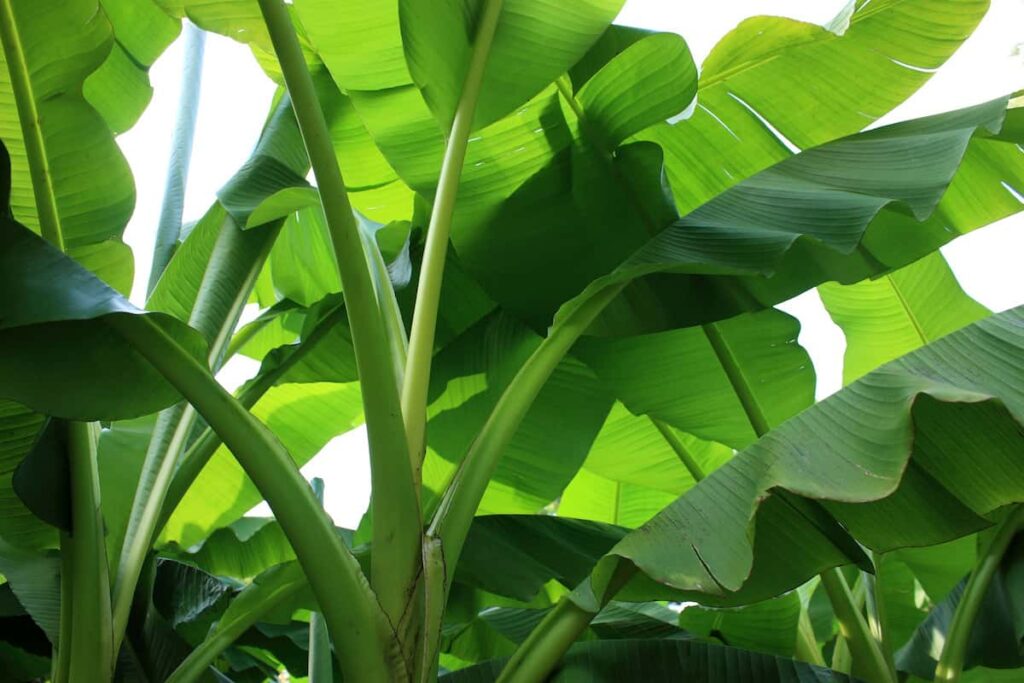
Drip rater requirement at different growth stages of Red Banana
Water is essential for the maximum productivity of the red Banana, a water-loving plant. However, banana roots do not draw much water from the ground. Therefore, drip irrigation should be used under Indian conditions to support banana production. It has been calculated that bananas require 2000 mm of water per year. Water use efficiency has been reported to be improved with drip irrigation and mulching technologies.
Under the drip system, water is saved by 56%, and yield increases by 23-32%. Plants should be irrigated immediately after planting. Maintain field capacity and apply sufficient water. Excess irrigation will result in root zone congestion as air is removed from soil pores, affecting plant establishment and growth. Red Banana requires drip irrigation for proper water management
| Sl.No | Crop growth stage | Duration (weeks) | Quantity of Water (liter/plant) |
| 1 | After planting / Ratoon | 1-4 | Flood irrigation |
| 2 | Juvenile phase | 5-9 | 8-10 |
| 3 | Critical growth stage | 10-19 | 12 |
| 4 | Flower bud differentiation stage | 20-32 | 16-20 |
| 5 | Shooting stage | 33-37 | 20 and above |
| 6 | Bunch development stage | 38-50 | 20 and above |
Fertilization in Red banana cultivation
The Banana requires many nutrients, often only partially supplied by the soil. In India, the nutrient requirement is 20 kilograms of farmyard manure, 200 grams of nitrogen, 60-70 grams of phosphorus, and 300 grams of potassium per plant. Bananas require a lot of nutrition. For a metric tonne yield of bananas, 7-8 kilograms of N, 0.7-1.5 kilograms of P, and 17-20 kilograms of potassium are required. The Banana responds well to nutrient applications.
Farmers traditionally use more urea and less phosphorous and potash. It is important to avoid the loss of nutrients from conventional fertilizers, such as leaching, volatilization, evaporation, and fixation of P and K in the soil. Drip irrigation (fertigation) is the most efficient way to apply water-soluble or liquid fertilizers. The result is a 25-30% increase in yield with fertigation. Moreover, it saves labor and time, and nutrients are uniformly distributed.
Weed management
- Pre-emergence application of Atrazine (within a week of planting) or simazine or Diuron at 1.5 to 2.0 kg/ha soon after planting would keep the field free from weeds for 3 to 5 months.
- At post emergence, paraquat (0.4 kg/ha) or Dalapon (3 to 4 kg/ha) or 2,4-D (0.5 kg/ha) or Glyphosate – 5th leaf stage – per plant 5ml/litre.
- Repeat after a month if needed. If weed growth is heavy at the later stage of the crop – one round, at per plant 10ml/liter.
Crops that can be intercropped with Red Banana
In the early stages of banana plantation growth, intercrops can be easily grown. The ideal crop to intercrop with Banana is radish, cauliflower, cabbage, spinach, chili, brinjal, colocasia, yam, Dioscorea, lady’s finger, marigold, tuberose, papaya, areca nut, coffee, and rubber. Compared to a pure banana crop, Bananas intercropped with bhindi had the highest total return, followed by cluster bean lablab, and Banana intercropped with bhindi had the lowest. It is, therefore, ideal for intercropping this crop with bananas.
In case you missed it: Terrace Gardening ideas for Home in India: For Vegetables, Fruits, Flowers, and Herbs
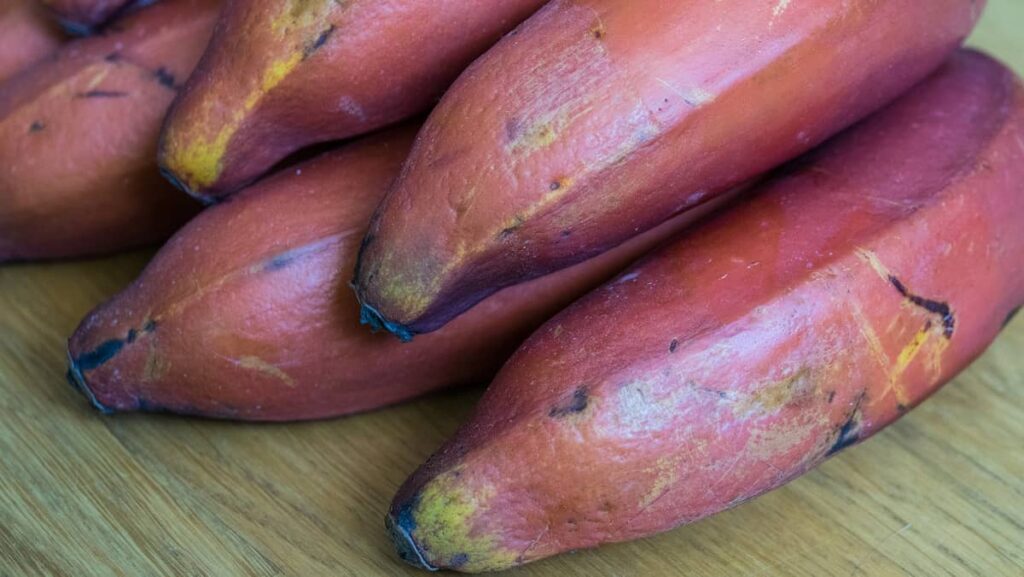
Red banana diseases
Banana Bract Virus
Symptom:
- Reddish brown streaks appear on suckers at emergence and when the leaf sheath separates from the central axis
- An elongated peduncle, clusters of leaves at the crown, and half-filled hands are its characteristic characteristics
- Viral transmission occurs through aphid vectors. Suckers infected with the virus are the primary carriers of the virus. The disease is transmitted by aphid vectors such as Aphis goosypii and Rhopalosiphum maidis.
Control and Management:
- Diseased plants must be removed as soon as possible to prevent the disease’s spread. Spray Phosphomidon at 1 ml per liter, Methyl Demeton at 2 ml per liter, or Monocrotophos at 1 ml per liter controls the insect vector.
- For new plantings, disease-free planting materials should be used
- During the off-season, weeds in nearby areas can harbor the virus
- Detecting diseased plants early and eradicating them from the field as soon as they are noticed through regular inspection of plant plantings
Bunchy Top: Banana bunchy top virus
Damages Symptom:
- Dark green veins appear at first on the lower portion of the leaf midrib and stem
- This disease’s name comes from the symptom of “bunching” at the top of the plant.
- A severely infected banana plant is unlikely to produce fruit, but if it does, the Banana’s hands and fingers are likely to be twisted and distorted.
- Infected suckers and banana aphids transmit the disease
Management
- A solution of 50 grams in 400 ml of water should be injected into the plants.
- Injection of Monocrotophos 4 ml (1:4) at 45-day intervals from 3rd month until flowering is recommended as a vector control
- Spraying plants with phosphomidon 1ml /l or Methyldemeton 2ml/ l or monocrotophos 1ml /l
In case you missed it: Powering Agriculture with Renewable Energy in India: How to Achieve, and Sustainable Benefits
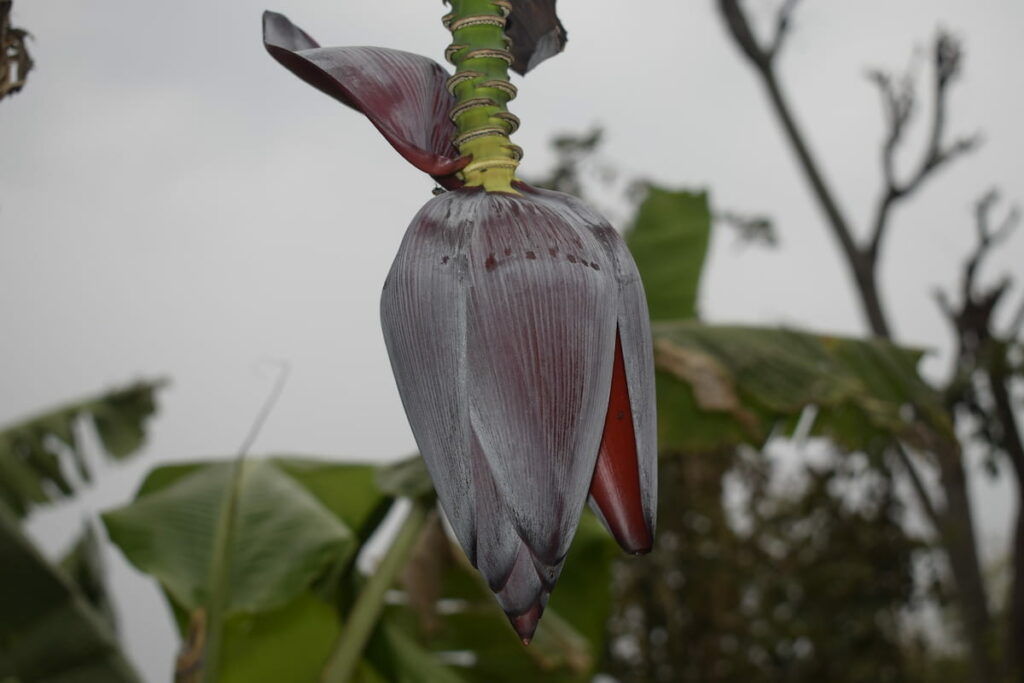
Infection chlorosis mosaic disease
Damage Symptom
- The margins of the leaves are rolled, the crown is twisted, and newly emerged leaves have a rigid erectness to them
- Dead or drying suckers indicate advanced cases of heart rot caused by the heart leaf and pseudostem rotting.
- The leaf lamina has broad chlorotic bands and patches or chlorotic mottling distributed in patches.
- Plants infected with this virus have narrower and smaller leaves, and their growth is slowed. As a result, these plants do not produce bunches but rather act as a reservoir for viruses
Management
- It is not recommended to plant suckers that are infected.
- During the off-season, weeds in the nearby area can harbor the virus.
- The banana crop should not be planted between pumpkins, cucumbers, and other cucurbits.
- Control insect vector by spraying Phosphomidon at 1 ml per liter or methyl demeton at 2 ml per liter.
Pests red banana crop
Pseudostem Borer
Damage symptoms
- Summer and monsoon are the most active months for the pest. This is because the grubs feed within the stem as they bore into it.
- The grub bores a hole in the ground and exudes sap and a blackened mass. In the end, the plant dies as a whole.
Control
- If the infection is severe, the plants should be uprooted and burnt. The application of aluminum phosphide (3 tablets/plant) is recommended for control of the egg, larva, pupa, and adult populations of the insect. Mud should be plastered over the slit after placing the tablet inside the pseudostem.
- It is important to cultivate a clean environment to control it. Carbofuran (three grams per stool) effectively controls the pest. The pest population can also be controlled using Endosulphan (0.04%) or Carbaryl WP (0.1%).
Rhizome Weevil
- Weevil borer larvae feed by tunneling in banana plants. Tunnels can extend several feet up the stem in severe cases.
- Decomposition of the corm results in rotten tissue.
- An injured corm prevents nourishment from reaching the plant. Therefore, leaves turn yellow, wither, and die.
- A heavily infected plantation produces little. Instead, they live under newly cut or rotting pseudostems and feed on dead or dying banana plants.
Control
- Plantations should be free of debris that can harbor borers. Between plants, old rhizomes or pseudostems are cut down, split, and placed on the plantation floor.
- During the summer, adult beetles migrate into these stems, where they can be collected by hand and poisoned. Suckers can be protected from weevil attacks by dipping them in Monocrotophos (0.5%) for 30 minutes before planting.
In case you missed it: High Yield Hybrid Guava Varieties in India: State Wise Cultivars
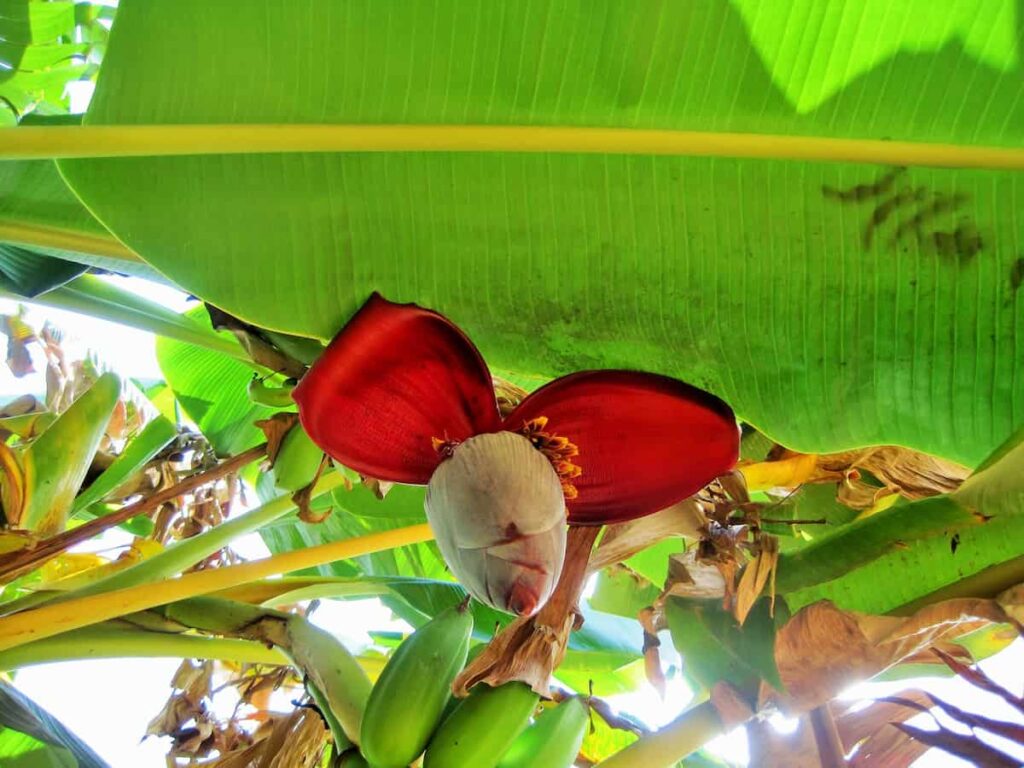
Banana Aphid
- The insect is the vector of the virus causing bunchy top disease. Yellowish-green nymphs and adults suck cell sap and devitalize plants.
- Affected parts become discolored and malformed. High humidity favors the rapid multiplication of this pest.
- The aphids are mostly observed on the lower surface of the leaves.
Control
- Spraying of Monocrotophos (0.05%) or Malathion (0.1%) at 10-15 days intervals contains aphid population effectively.
- Granular insecticides like Phorate at 1.0 kg a.i./ha should be applied to the soil to prevent the recurrence of the pest.
Conclusion
Beta-carotene and vitamin C are more abundant in this variety of bananas than in yellow bananas. Additionally, it contains potassium and iron. The redder the banana fruit, the greater the amount of carotene and vitamin C. Red bananas ripen quickly at room temperature and are best stored outside refrigeration.
- Sheep Farming Business Plan for Beginners
- Aquaponic Farming at Home: A Step-By-Step Guide
- Profitable Village Farming Business Ideas in 2024
- High-Yield Aquaculture: Fast-Growing Fish for Farming
- Effective Fish Pond Construction Techniques for Beginners
- Irrigation and Water Management in Pineapple Farming
- Blossom to Harvest: Mastering Flowering and Pollination in Papaya Farming
- Pig Fattening Essentials: From Selection to Sale for Beginners
- Raising Wagyu Cattle: A Complete Guide for Premium Beef Production
- Soil Types and Their Water Holding Capacity
- Optimizing Irrigation Schedules for Coconut Groves for Enhanced Yield
- Espresso Your Garden: Coffee Grounds for Healthier Acid-Loving Plants
- The Best Soil Mix for Snake Plants: How to Mix Your Own Snake Plant Soil
- Green Thumb Success: Expert Tips for Cultivating Greenhouse Beans All Year Round
- Bloom All Year Round: The Ultimate Guide to Indoor Hyacinth Care
- Eco-Friendly Gardening: How to Make Liquid Fertilizer from Kitchen Waste
- Ultimate Guide to Grow Anise in Pots: Explore Seed Propagation to Harvesting
- Guide to Raising Chester White Pigs: Discover Breed Facts to Growth Management
- Mastering the Elegance: The Ultimate Guide to Weeping Cherry Tree Care, Planting, and Maintenance
- Ultimate Guide to Planting Garlic in Grow Bags: Growing Strategies for Beginners
- How to Fix Spider Plant Leaf-Related Problems: Natural and Organic Remedies
- 10 Reasons Why Your Tulsi Plant is Shedding Leaves: Home Remedies and Solutions
- Optimizing Growth and Yield: The Advantages of Palm Bunch Ash Fertilizer
- Utilizing Neem Oil Extract as a Natural Pesticide for Hydrangea
- From Soil to Harvest: Various Ways in Which Farmers Can Use AI Tools
- Steps to Encourage and Induce Citrus Flowers: A Comprehensive Guide
- How to Fix Snake Plant Leaf-Related Issues: Natural and Organic Remedies
- Transform Your Garden into a Fragrant Oasis with Raat Ki Rani (Night Blooming Jasmine)
- Discover the Ideal Chicken Breeds for Philippine Farms
- How to Create a Poultry Egg Farm Business Plan for Profits
- Grow Lemon Cucumbers Like a Pro: Insider Techniques for Bountiful Yields
- Ultimate Guide to Caring for Your Pink Princess Philodendron: Tips for Thriving Variegation
- Areca Nut Profit Per Acre: Calculating Yield and Cost of Cultivation
- How Kaveri Chicken is Becoming a More Profitable Breed in Indian Backyards
- Transform Your Barn: 9 Steps to Convert a Horse Stall into a Chicken Coop
- Exploring Suffolk Sheep Disadvantages with Limitations and Challenges
